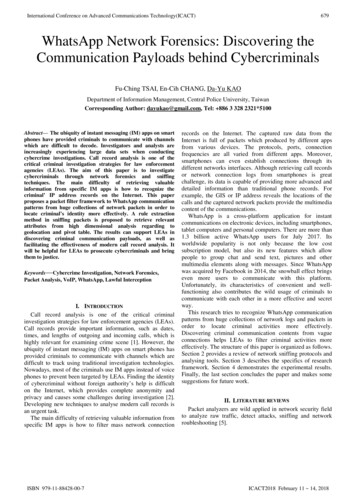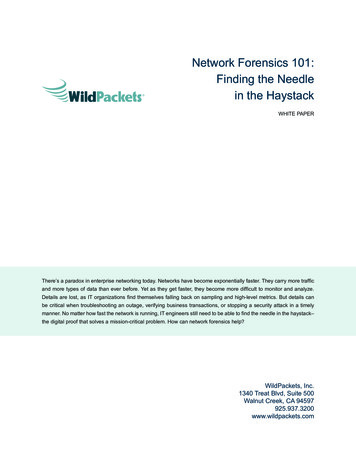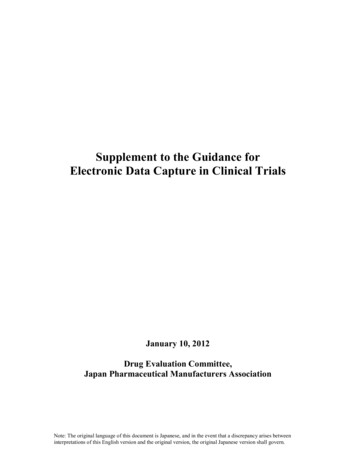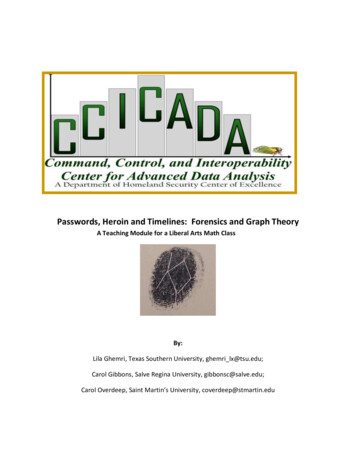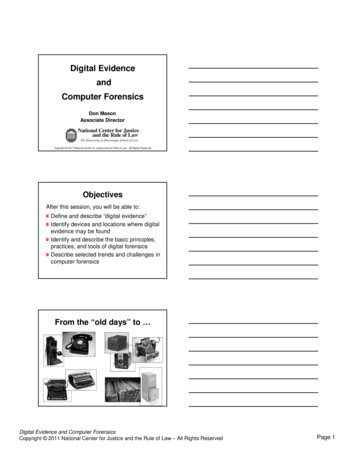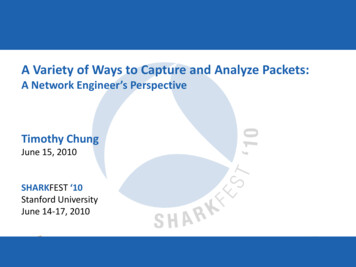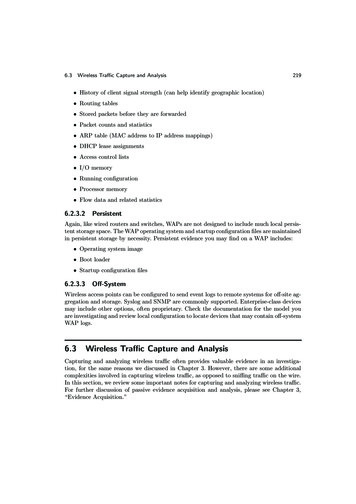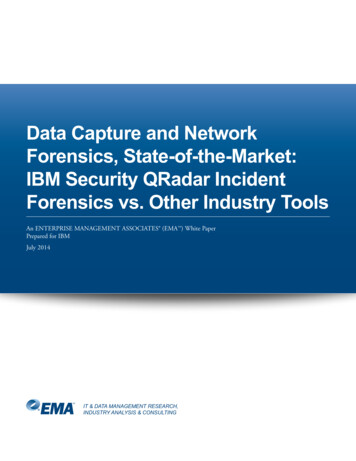
Transcription
Data Capture and NetworkForensics, State-of-the-Market:IBM Security QRadar IncidentForensics vs. Other Industry ToolsAn ENTERPRISE MANAGEMENT ASSOCIATES (EMA ) White PaperPrepared for IBMJuly 2014IT & DATA MANAGEMENT RESEARCH,INDUSTRY ANALYSIS & CONSULTING
Data Capture and Network Forensics, State-of-the-Market:IBM Security QRadar Incident Forensics vs. Other Industry ToolsExecutive SummaryThe ability to capture, consume and correlate multifaceted data from all over the enterprise is a growingneed. No single data source or type can provide sufficient forensic capabilities to solve all of today’ssecurity problems. ENTERPRISE MANAGEMENT ASSOCIATES (EMA ) end-user researchdemonstrates that the data needs of security organizations are growing at breakneck speeds reachingvolumes associated with big data. Log information from network and server infrastructure is no longersufficient to provide a full picture. Security needs to process a broader and richer data set includingnetwork and big data repositories. Additionally, the security technology has to be able to correlatecommonalities within those variant data streams to produce meaningful data trails and do it in as nearto real time as possible. A 2013 study by Ponemon Institute identified that if a security incident can beresolved in less than 60 seconds, the remediation costs could be reduced by as much as 40%.Traditional log management tools do not contain the range of data or data mining and analysiscapabilities to deliver true security analytics and forensics. Security Incident Event Management(SIEM) tools provide more capabilities but are also insufficient for full forensic analysis. Fifty-threepercent of EMA research respondents understood that security analytics and forensics tools augmentedtheir SIEM tools and 46% understood that security analytics and forensics tools were a naturalevolution of the traditional SIEM. A good rule to follow is that a SIEM should provide correlation,normalization and alerts on key events and have the ability to query the data to retrieve answers tocomplex questions about the specific environment. A security analytics solution is able to adapt to theactivities and behaviors within its monitored environment providing improved visibility into activitiesand why they should be investigated. It can ingest non-standard log data types at big data proportionsto provide visibility into abstract data relationships bringing attention to problems that operators andadministrators hadn’t even thought of.The introduction of a forensics solution will provide the increased capabilities to reduce false positivesand time spent per case, thereby increasing the incident response team’s ability to process the keyhighest risk incidents first and faster, and create a proper case file to manage all of the required data.Having the capability of doubling the number of incidents the response team can resolve in minutesmakes choosing the right solution imperative. This EMA report evaluates security forensics tools froman operations standpoint and identifies IBM Security QRadar as a leader among those evaluated.The investigation discusses the evaluation criteria for six tools widely recognized for their support inforensics data gathering and processing, and provides evaluation input on several other tools. QRadarbest met the operations evaluation criteria of all of the reviewed solutions.1 2014 Enterprise Management Associates, Inc. All Rights Reserved. www.enterprisemanagement.comPage 1
Data Capture and Network Forensics, State-of-the-Market:IBM Security QRadar Incident Forensics vs. Other Industry ToolsTable of ContentsExecutive Summary. 1Introduction. 3Tools Reviewed. 4EMA Perspective. 4Product Comparative Summary. 5TCPdump/Windump – Overall Rating 0.5. 5Wireshark – Overall Rating 1.83 . 6NOTE to the Reader: . 7Niksun NetDetector – Overall Rating 2.83. 8RSA Security Analytics – Overall Rating 3.08. 9Bluecoat Security Analytics Platform – Overall Rating 3.16. 10LogRhythm Network Monitor – Overall Rating 3.21. 12IBM Security QRadar Incident Forensics – Overall Rating 3.92. 13Summary. 15 2014 Enterprise Management Associates, Inc. All Rights Reserved. www.enterprisemanagement.com
Data Capture and Network Forensics, State-of-the-Market:IBM Security QRadar Incident Forensics vs. Other Industry ToolsIntroductionThere is an increasing number of security tools that profess to deliver “actionable intelligence” or“actionable insights” to operators and analysts to improve security response. While many of them areout of scope for this evaluation, it is important to note that “Buzzword Bingo” is proliferated by vendorsof diverse technology to gain attention in the security space. This approach confuses consumers and isfrequently exacerbated in areas of emerging technology like security analytics and forensics. This paperattempts to reduce the confusion on what should qualify as a forensics solution and comparativelyevaluate some of the products in the space.One foundational note is that traditional log management tools do not qualify as forensics tools. Thoughthey collect logs, they do not have full packet capture capability and therefore do not contain thebreadth of data or data mining and analysis capabilities to deliver true security analytics and forensics.Security Incident Event Management (SIEM) tools, provide more capabilities than log managementtools but are also insufficient for full forensic analysis. In the latest EMA security research, it was clearthat security professionals get this. Only 1% of the respondents thought that security analytics as afunction or toolset was a rebranding of SIEM. Fifty three percent understood that security analytics andforensics tools could augment their SIEM tools and 46% had the understanding that security analyticsand forensics tools were a natural evolution of the traditional SIEM. That perspective can be seen in themarketplace with many vendors trying to rebrand their SIEM as security analytics tools without thechange in capabilities necessary to substantiate it. A good rule to follow is that a SIEM should providecorrelation, normalization and alerts on key events and the ability to query the data to retrieve answersto complex questions about the specific environment. A security analytics solution is able to adaptto the activities and behaviors within its monitored environment providing improved visibility intoactivities and why they should be investigated.Ninety-five percent of the organizations that implemented an analyticsor forensics solution indicated that they received “expected or greaterthan expected value” from the solution. This was the highest combinedvalue statement of any of the 13 technologies evaluated in the research.Additionally, EMA research showed that a significant contributor to thatvalue statement came from the ability of those tools to gather, reveal andanalyze forensic data. Operations teams using these solutions moved thevolume of cases they could resolve in minutes from an average of 12% oftheir case load to an average of 24% of their case load. The ability of thetool to use more data to come to a better conclusion also reduced falsepositives, aided alert prioritization, drove a decrease in staff burdens andcase backlog, reduced per case cost of resolution and ultimately loweredcost of resolution for incidents.Ninety-five percent ofthe organizations thatimplemented an analytics orforensics solution indicatedthat they received “expectedor greater than expectedvalue” from the solution.Forty-five percent of the organizations that had a security analytics solution in place said they wereconfident that they could detect and remediate a security incident prior to it having a significantimpact. This was the highest level of confidence among 13 different security technologies investigated.In addition to higher confidence levels for response, 90% of the respondents said that the introductionof the solution had reduced false positives and improved their actionable alerts.3 2014 Enterprise Management Associates, Inc. All Rights Reserved. www.enterprisemanagement.comPage 3
Data Capture and Network Forensics, State-of-the-Market:IBM Security QRadar Incident Forensics vs. Other Industry ToolsTools ReviewedGiven the numerous tools available in the market place that will supportforensics to one degree or another, it is impossible to review all of themin the scope of this paper. Several of the more commonly known and/or used tools that provide forensic capabilities have been chosen. Thetools chosen were billed by their respective companies as being createdto provide forensics capabilities. The paper also identifies other tools thatcompete in the space but does not go into detail on those tools. Thelisting is more to make the reader aware of them.Operations teams usingthese solutions moved thevolume of cases they couldresolve in minutes from anaverage of 12% of theircase load to an average of24% of their case load.The tools that are reviewed in this paper in conjunction with IBM Security QRadar Incident Forensics are:1. RSA Security Analytics – Originally named NetWitness, acquired by EMC in April 2011, andrebranded RSA Security Analytics.2. Bluecoat Security Analytics Platform – Previously Solera DeepSee, it was acquired by BluecoatSystems in May 2013 and rebranded.3. LogRhythm Network Monitor – Introduced by LogRhythm as part of its 5.1 release in July2011.4. Niksun NetDetector – Created in 1997 by Dr. Parag Pruthi as a network monitoring solution tocapture and analyze network traffic.5. Wireshark – Network packet captures software released by Gerald Combs in 1998. Originallynamed Ethereal and rebranded in 2006 to Wireshark.6. TCPdump (for Linux/UNIX) – Originally created in 1987 by Van Jocobson, Craig Leres andSteven McCane for network packet capture in Linux/Unix systems. Ported to Windows as WinDump about 2000.7. Splunk1 and HP ArcSight ESM2 were not evaluated in this paper because they do not directlyprocess real-time network captures.EMA PerspectiveNetworks, network connected systems, and the underlying data are under constant reconnaissanceand/or attack from both within and without. Hacktivists, organized crime, and corrupt or disgruntledinsiders seem to be everywhere. The current state of being is for companies to assume they have beenor will be compromised. Security organizations must be vigilant in identifying threats and dealing withthem. Because of the sophistication of many attacks, security needs tools that can peel back the layers ofactivities, revealing their true nature. Traditional Security Information and Event Management (SIEM)are only so good and do not have the full range of capabilities necessary to provide the complete picture.Security analytics and forensics solutions are the best means of making the correlations and respondingin a timely manner. Advances in machine learning and user interface design mean forensic capabilitiesare no longer tools only for law enforcement or post event consultants.Each tool reviewed was evaluated against each of the 6 criteria. Each tool and the evaluation criteria aredocumented below with commentary of the rating and why that rating was given. The ratings for eachcategory are 0–4. A zero indicates very poor to no support for a given criteria. A four indicates very goodsupport for the watch?v McNfhVJLqUs 2014 Enterprise Management Associates, Inc. All Rights Reserved. www.enterprisemanagement.comPage 4
Data Capture and Network Forensics, State-of-the-Market:IBM Security QRadar Incident Forensics vs. Other Industry ToolsProduct Comparative Summary3TCPdump/Windump – Overall Rating 0.5TCPdump/Windump and similar tools have been aroundfor years. They were included in this paper because theyhave withstood the test of time. Being free tools, manypractitioners have used them and can therefore relate to thecomparison with the other tools in the list. TCPdump andWindump are considered first- generation tools.User Interface – 0Figure 1: TCPdump interfaceThe user interface is a no-frills, command-line, switchdriven view providing output from the packets intercepted broken down by field. The data scrolls upthe screen and can be redirected into a packet capture (Pcap) file for later review. Being command linerather than graphical (GUI), the interface has no modularity, user customizability, or data pivoting.Getting to the raw data requires accessing the Pcap file.Data Visualization – 0TCPdump and Windump are not designed for any data visualization. To get any flow visualizations,the Pcap file must be exported into other tools like Wireshark.35 ! LogRhythm requires Pcap export to Wireshark or other tool for document reconstruction* Search limited due to lack of metadata and/or endpoint data Does not provide bubble flows@ Does not collect machine/endpoint data% Though it can consume and create Pcap files, Wireshark is meant to operate as a standalone tool.& Requires some additional integration to maximize benefit.# This figure was updated post webinar due to additional information made available 2014 Enterprise Management Associates, Inc. All Rights Reserved. www.enterprisemanagement.comPage 5
Data Capture and Network Forensics, State-of-the-Market:IBM Security QRadar Incident Forensics vs. Other Industry ToolsData Capture and Reconstruction – 1Designed for use on a single system, TCPdump and Windump onlycapture network traffic on a single interface card at a time. This limits thescope of the total data captured. If a network tap or span port is available,it can be used to capture traffic from that port, which widens the scopeof its data capture.TCPdump and Windump do not provide data reconstruction. All datais in the individual packets in which it was captured. They also have noapplication (layer 7) context to aid in understanding application misuse.TCPdump and Windump are purely network centric and cannot providecontext for end host and other non-packet centric data.Forty-five percent oforganizations that hada Security Analytics orForensics solution said theywere confident that theycould detect and remediatea security incident prior to ithaving a significant impact.Solution Integration – 1TCPdump and Windump are meant to work as standalone tools. They can create Pcap files for use inother tools like Wireshark.Data Search Capabilities and Performance – 0These tools require use of systems tools such as grep or awk or customized scripts to be written to locateand extract data on UNIX systems. On Windows, it requires either DOS tools like findstr or texteditors (Notepad/WordPad) using the built in search function.Skill Required – 1These tools are easy to set up and gather data, but to maximize results, the analyst must fully understandthe switches that can be used. To process and extract data, the user must understand ASCII, hex, binary,uuencoding, and other text formats. The tools do no preprocessing to aid the analyst.Wireshark – Overall Rating 1.83Wireshark was created because TCPdump did not provideenough usability. Wireshark is considered a secondgeneration network troubleshooting tool due to its limitedforensics capabilities.User Interface – 34As of 2014, Wireshark released a new interface based uponQT to improve its flexibility and improve performance onMacOS. Users can add, remove and rearrange columns toFigure 2: Wireshark interfaceisolate data in the capture. Data filters can be applied onsingle or multiple columns. The current version also has the ability to create user profiles allowingdifferent setups to be used by one or more users. Data can be captured from a single interface live, or aPcap file can be fed in to review data historically.The interface has no modularity, but profiles and columnar changes provide a reasonable amount ofcustomizability within the scope of what it delivers. Rudimentary data pivoting can be accomplishedwith the filtering system. Getting to the raw data requires accessing the Pcap file.46 he user interface does not have the same breadth of abilities that the tools rated later in this report have. It is simple. ItThas few bells and whistles but what it does have, it uses well which is why it was rated a 3 out of 4. 2014 Enterprise Management Associates, Inc. All Rights Reserved. www.enterprisemanagement.comPage 6
Data Capture and Network Forensics, State-of-the-Market:IBM Security QRadar Incident Forensics vs. Other Industry ToolsData Visualization – 1Data visualization is provided by use of line coloring to representvarious characteristics within the packet structure and data flows. Thisis a significant improvement over TCPdump but not sufficient forperforming any advanced analytics.Data Capture and Reconstruction – 2Nintey percent of surveyrespondents said theintroduction of an Analyticssolution had reduced falsepositives and improvedtheir actionable alerts.Wireshark is designed for use on a single system and only capturesnetwork traffic on a single interface card, limiting the total scope of captured data. If a network tap orspan port is available, it can be used to capture traffic from that port, which widens the scope of its datacapture. It can also import previously captured data from a Pcap file.Wireshark does provide file reconstruction. Multiple file types such as text5 and graphics6documents can be reconstructed if the entire conversation was captured; however, accomplishing thiscan be labor intensive. Document reconstruction may require searching for key hex strings outside ofWireshark, depending upon the document file type, significantly impeding the time to resolve an incident.Solution Integration – 1Wireshark works primarily as a standalone tool. However, given that it can import Pcap files from othertools it does provide a limited sort of integration with tools that generate Pcap output.Data Search Capabilities and Performance – 2The columnar/field data filtering can be useful if you know the data string or the field name containingthe associated data to locate the target. It’s a far step up from TCPdump, but the impediment is havingto know the specific details.The speed of the search is usually very fast, but can be significantly dependent upon the size of the Pcapand the system resources.Skill Required – 2Wireshark is easy to download, install, and begin using, but requires a significant amount of networkpacket disassembly knowledge. The user will need to have other tools at his/her disposal to extract,decode, and utilize packet contents such
Bluecoat Security Analytics Platform– Previously Solera DeepSee, it was acquired by Bluecoat Systems in May 2013 and rebranded. 3. LogRhythm Network Monitor– Introduced by LogRhythm as part of its 5.1 release in July 2011. 4. Niksun NetDetector – Created in 199
